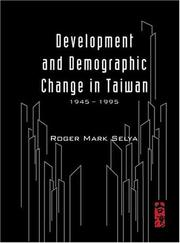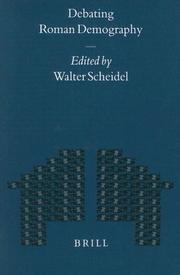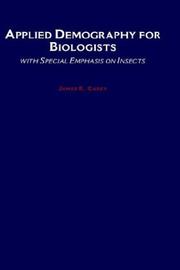| Listing 1 - 10 of 498 | << page >> |
Sort by
|
Book
ISBN: 3030375552 3030375544 Year: 2020 Publisher: Cham : Springer International Publishing : Imprint: Springer,
Abstract | Keywords | Export | Availability | Bookmark
 Loading...
Loading...Choose an application
- Reference Manager
- EndNote
- RefWorks (Direct export to RefWorks)
This monograph outlines an integrative framework that conceptualizes the role of relations of control in human reproduction and long-term population dynamics. It thereby draws on the demographic transition theory, sexuality studies, Foucault’s concept of bio-power and sexuality as key to social control, cognate concepts and theories, and on findings from demography, anthropology, archaeology and other disciplines. The framework is based on the premise that four demographic regimes can be identified over the course of human history. They are defined by the primary locus and modus of control over reproduction. The framework questions some of the basic postulates in population studies, including how demographic transitions are interpreted. As such this book contributes to the debate on the longer-term trends in population dynamics and the relations of power and control in human reproduction.
Demography. --- Historical demography --- Social sciences --- Population --- Vital statistics
Periodical
ISSN: 21647070 23642289 Year: 2013 Publisher: Fairfax, Va. : Roy Rosenzweig Center for History and New Media
Abstract | Keywords | Export | Availability | Bookmark
 Loading...
Loading...Choose an application
- Reference Manager
- EndNote
- RefWorks (Direct export to RefWorks)
Demography --- Demography. --- Historical demography --- Social sciences --- Population --- Vital statistics --- Démographie
Book
ISBN: 9783030764333 3030764338 Year: 2022 Publisher: Cham Springer International Publishing :Imprint: Springer
Abstract | Keywords | Export | Availability | Bookmark
 Loading...
Loading...Choose an application
- Reference Manager
- EndNote
- RefWorks (Direct export to RefWorks)
Demography. --- Historical demography --- Social sciences --- Population --- Vital statistics
Book
ISBN: 303076432X 3030764338 Year: 2022 Publisher: Cham, Switzerland : Springer,
Abstract | Keywords | Export | Availability | Bookmark
 Loading...
Loading...Choose an application
- Reference Manager
- EndNote
- RefWorks (Direct export to RefWorks)
Demography. --- Historical demography --- Social sciences --- Population --- Vital statistics
Periodical
Abstract | Keywords | Export | Availability | Bookmark
 Loading...
Loading...Choose an application
- Reference Manager
- EndNote
- RefWorks (Direct export to RefWorks)
Demography --- Mathematical models --- Mathematics --- Mathematical models. --- Mathematics. --- Historical demography --- Social sciences --- Population --- Vital statistics
Book
ISBN: 3319948695 3319948687 9783319948683 Year: 2019 Publisher: Cham: Springer,
Abstract | Keywords | Export | Availability | Bookmark
 Loading...
Loading...Choose an application
- Reference Manager
- EndNote
- RefWorks (Direct export to RefWorks)
This book presents a cross section of the work and concerns of social demographers worldwide, covering a broad range of topics from social structure through population structure to social policy; from fertility and mortality through migration to the way in which organisations deal with the demographic environment in which they operate. Topics addressed also include morbidity and health profiles and transitions, as well as policies and programs concerned with these and other issues. The volume touches on some of the major links between population and societal dynamics. It addresses demographic patterns and issues from micro-level, meso-level, and macro-level perspectives and helps put into focus the past, present and future of the mutual relations between population dynamics and societal responses. With a unique introductory chapter discussing the global unevenness of population growth today, its associations with inequality and the challenges it presents for the future, and a truly international approach to social and demographic change and policy responses, this book will serve as a valuable resource for professionals and students in sociology, demography, social policy and local governance.
Demography. --- Sociology, general. --- Historical demography --- Social sciences --- Population --- Vital statistics --- Sociology. --- Social theory --- Demography

ISBN: 1281933694 9786611933692 9812791159 9789812791153 9789812386663 9812386661 9781281933690 Year: 2004 Publisher: [River Edge] N.J. World Scientific
Abstract | Keywords | Export | Availability | Bookmark
 Loading...
Loading...Choose an application
- Reference Manager
- EndNote
- RefWorks (Direct export to RefWorks)
This book describes and analyzes the demographic changes that took place in Taiwan between 1945 and 1995. It uses an interdisciplinary methodology so that different approaches to demographic change can be compared and contrasted. It attempts to evaluate Taiwan's experience so that lessons for the Third World can be extracted. The content and presentation of the material are deliberately designed to replicate the 1954 work of Barclay, Demographic Change and Colonial Development in Taiwan. As such the book seeks to provide the reasons that economic development without demographic change took pla
Demography --- Historical demography --- Social sciences --- Population --- Vital statistics --- Taiwan --- Population. --- Social conditions

ISBN: 9004115250 9004351094 9789004115255 9789004351097 Year: 2000 Volume: 211 Publisher: Leiden BRILL
Abstract | Keywords | Export | Availability | Bookmark
 Loading...
Loading...Choose an application
- Reference Manager
- EndNote
- RefWorks (Direct export to RefWorks)
In conjection with an extensive critical survey of recent advances and controversies in Roman demography, the four case-studies in this volume illustrate a variety of different approaches to the study of ancient population history. The contributions address a number of crucial issues in Roman demography from the evolution of the academic field to seasonal patterns of fertility, the number of Roman citizens, population pressure in the early Roman empire, and the end of classical urbanism in late antiquity. This is the first collaborative volume of its kind. It is designed to introduce ancient historians and classicists to demographic, comparative and interdisciplinary perspectives, and to situate and contextualize Roman population studies in the wider ambit of historical demography.
Demography --- Démographie --- Rome --- Population --- History --- Histoire --- -Historical demography --- Social sciences --- Vital statistics --- -History. --- -Rome --- Démographie --- Rim --- Roman Empire --- Roman Republic (510-30 B.C.) --- Romi (Empire) --- Historical demography --- Byzantine Empire --- Rome (Italy) --- History. --- Demography - Rome.

ISBN: 0195066871 9780195066876 1423764390 9781423764397 9781601297976 1601297971 1280440694 9786610440696 0198023146 0197700217 Year: 1993 Publisher: New York Oxford University Press
Abstract | Keywords | Export | Availability | Bookmark
 Loading...
Loading...Choose an application
- Reference Manager
- EndNote
- RefWorks (Direct export to RefWorks)
The aim of this text is to introduce biologists and entomologists to population studies and demonstrate how demographic principles and techniques can be applied in research. The volume also serves as a graduate text in basic demography for advanced biology and ecology students.
Population biology. --- Demography. --- Animal ethology and ecology. Sociobiology --- Demography --- Historical demography --- Social sciences --- Population --- Vital statistics --- Biology --- Ecology
Book
ISBN: 9780833086709 0833086707 Year: 2014 Publisher: RAND Corporation
Abstract | Keywords | Export | Availability | Bookmark
 Loading...
Loading...Choose an application
- Reference Manager
- EndNote
- RefWorks (Direct export to RefWorks)
Family planning --- Demography --- Historical demography --- Social sciences --- Population --- Vital statistics --- Parenthood, Planned --- Planned parenthood --- Planning --- Birth intervals --- Family size
| Listing 1 - 10 of 498 | << page >> |
Sort by
|

 Search
Search Feedback
Feedback About UniCat
About UniCat  Help
Help News
News